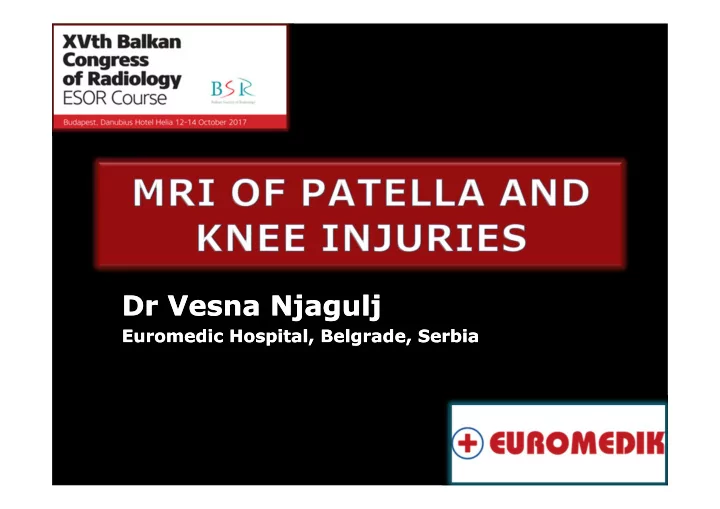

Knee joint has been in existence for over 320 million years • The Eryops, the ancestors of the reptiles, birds and mammals, • seems to be the first creature in the animal kingdom with a bicondylar knee joint The patellofemoral joint, however, only began to develop some 65 • million years ago Tria AJ Jr, Alicea JA (1995) Embryology and anatomy of the patella. In: Scuderi GR (ed) The patella. Springer, Berlin Heidelberg New York, pp 11–23
• 2 facets (±odd facet) • Trohlear groove
• Passive stabilizers: patellar ligament, medial and lateral patellar retinaculum
MPFL the major passive restraint preventing lateral patellar • dislocation MPFL arises between the adductor tubercle and the medial • epicondyle (the site of origin of the tibial collateral ligament) The ligament runs forward just deep to the distal vastus • medialis obliquus muscle to attach to the superior two thirds of the medial patella margin
• D The medial patellofemoral ligament can attach only to the tibial collateral ligament or to both the tibial collateral ligament and the femoral epicondyle. The bilaminar and trilaminar appearances of the medial patellar ligamentous complex and the course of the medial patellofemoral, medial patellomeniscal, and medial patellotibial ligaments were best defined on axial images Dirim et al., AJR 2008
• The four quadriceps muscles form the active stabilizers of the patella
• Complex biomechanical forces during all levels of activity • The force varies from half body weight during walking, up to 25 times body weight on lifting a weight with the knees flexed at 90
Noyes Knee Institute In the fully extended knee the patella lies superior to the trochlear cartilage. Beyond 120, contact is reduced between the patella and trochlea.
• Common disorders in athlets • Overuse injuries • Repetetive stress • To separate patellar overuse from instability • Classic patellofemoral overload is a multifactorial problem • Sesamoid bone – patella
Repetitive microtrauma at the entheses of the patellar tendon - patellar • tendinosis Tendon rupture (partial or complete) • Quadriceps tendon injuries • Injuries of retinacula • Bursea inflammation - overuse, friction or trauma • Several impingement and plica syndromes • Avulsion injuries (repetetive microtrauma, unbalanced and eccentric • muscle contractions). Avulsion - of the bone or/and the cartilage Typical imaging findings after patellar dislocation • Osteochondral injuries and fractures • Variations •
31y.m, soccer player, anterior knee pain Jumper’s knee • (overuse / trauma + -)
12 y. m, soccer player, anterior knee pain, more during activity Mb. Sinding-Larsen-Johansson • - “stress related“ unjury, involving bone, not cartilage (fragmentation and separation of the patella) - DDx patellar sleeve fx
B-PT-B surgery, ACL reconstruction •
Dynamic patellofemoral alignment during knee motion • Malalignment and maltracking refer to conditions in • which there is an imbalance of forces on the patella that produce abnormalities of alignment and tracking The result of PF malalignment and maltracking is • unfavourable stresses and shearing forces that exceed the physiological threshold of tissues and may result in cartilage damage, degenerative changes, strain of ligamentous structures, mechanical failure or patellar dislocation. Njagulj et al, ESSR 2013
16-y, m, soccer player, with a history of recurrent patellar instability
22y.m, professional basketball player, acute injury
www.youtube.com
Endo et al; Sports Health 2011 Noyes Knee Institute Various parameters can be used in the assessment of patellar • maltracking Static MRI measurements that are routinely used as indicators of • patellofemoral alignment during knee movement The most commonly used measurements are: trochlear depth, the tibial tuberosity-trochlear groove distance (TT-TG), patellar translation, the patellofemoral angle (PFA) and the Insall-Salvati index
>20 mm is considered abnormal For surgical treatment 25mm
Hoffa's fat pad, infrapatellar fat pad, plays a role in stabilizing the patella in • extremes of flexion and extension Infrapatellar fat pad impingement – anterior knee pain • This signal abnormality in superolateral Hoffa's fat pad is a secondary sign of • patellofemoral maltracking
15y, F, 2y after surgery
27y, F ???
Knee joint articulations change significantly during flexion using upright weight-bearing CT. Progressive internal tibiofemoral rotation leads to a decrease in the TTTG and a posterior shift of the contact points in higher degrees of flexion. This elucidates patellar malalignment predominantly close to extension and meniscal tears commonly affecting the posterior horns. Femoral MPFL-graft fixation is patient specific
For a more precise evaluation of trochlear dysplasia, the entire distal femur should be analyzed on axial MRI.
Images: 1. Diagnostic Imaging Center, Institute of Oncology in Sremska Kamenica, Serbia (RS) 2. Diagnostic Center VAMED Novi Sad, Serbia (RS) 3. General Hospital Subotica, Serbia (RS) 4. Diagnostic Center MR Vukovi ć S- Sombor, Serbia (RS) 5. Euromedic Hospital Belgrade, Serbia (RS)
THANK YOU FOR YOUR ATTENTION
Recommend
More recommend